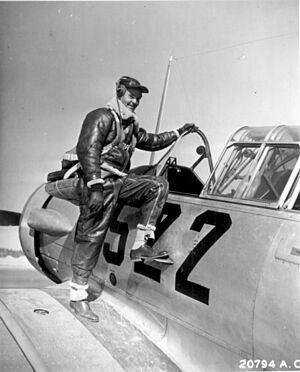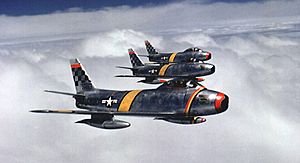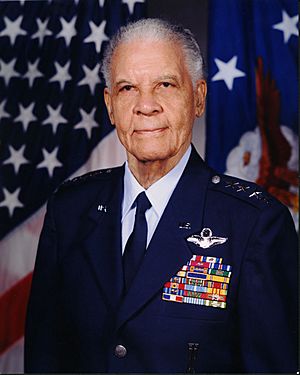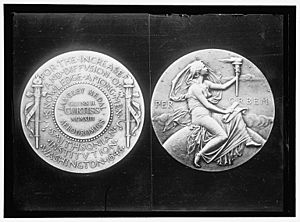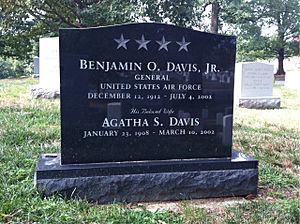Benjamin O. Davis Jr. facts for kids
Quick facts for kids
Benjamin O. Davis Jr.
|
|
|---|---|
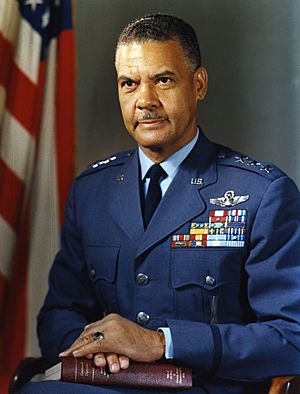 |
|
| Born | December 18, 1912 Washington, D.C., United States |
| Died | July 4, 2002 (aged 89) Washington, D.C., United States |
| Buried | |
| Allegiance | United States |
| Service/ |
United States Army United States Air Force |
| Years of service | 1936–1970 |
| Rank | General |
| Commands held | 99th Pursuit Squadron 332nd Fighter Group Tuskegee Airmen 51st Fighter Wing Thirteenth Air Force |
| Battles/wars | World War II Korean War Second Taiwan Strait Crisis Vietnam War |
| Awards | Air Force Distinguished Service Medal (2) Army Distinguished Service Medal Silver Star Legion of Merit (3) Distinguished Flying Cross Air Medal (5) Army Commendation Medal (3) Langley Gold Medal |
| Relations | Benjamin O. Davis Sr. (father) |
| Other work | Federal Sky Marshal Program Assistant Secretary of Transportation |
Benjamin Oliver Davis Jr. (born December 18, 1912 – died July 4, 2002) was a brave United States Air Force (USAF) general. He was famous for leading the World War II Tuskegee Airmen.
He made history as the first African-American brigadier general in the U.S. Air Force. Later, in 1998, President Bill Clinton promoted him to a four-star general. During World War II, General Davis commanded the 99th Fighter Squadron and the 332nd Fighter Group. These groups protected bombers flying missions over Europe. Davis flew 60 missions in different fighter planes like the P-39 Airacobra, P-40 Warhawk, P-47 Thunderbolt, and P-51 Mustang. He was one of the first African-American pilots to fight in combat. His father, Benjamin O. Davis Sr., was also a trailblazer, becoming the first black brigadier general in the United States Army.
Contents
Early Life and Dreams
Benjamin Oliver Davis Jr. was born in Washington, D.C., on December 18, 1912. He was the second of three children. His father was a U.S. Army officer. When Benjamin Jr. was 13, in 1926, he flew in a plane with a pilot at Bolling Field. This amazing experience made him want to become a pilot himself. In 1929, he finished high school in Cleveland, Ohio. He then went to Western Reserve University for a year.
Starting His Military Journey
After attending other universities, Davis entered the United States Military Academy (West Point) in July 1932. He graduated in 1936, becoming the first black person to graduate from West Point since 1889. During his four years there, his white classmates often ignored him because of his race. They hoped this "silent treatment" would make him leave. But it only made him stronger and more determined to succeed.
His hard work earned him respect. The 1936 yearbook, the Howitzer, praised his courage and determination. Davis graduated 35th in his class of 276. He was the fourth black graduate in the academy's history. After graduating, he married Agatha Scott.
In 1936, the U.S. Army sent Davis to the all-black 24th Infantry Regiment at Fort Benning, Georgia. He was not allowed into the officers' club there because of his race. Later, he taught military tactics at Tuskegee Institute in Alabama. This assignment was similar to one his father had received. It was a way for the Army to avoid putting a black officer in charge of white soldiers.
World War II Heroics
In 1941, the government decided to create a black flying unit. Captain Davis was chosen for the first training class at Tuskegee Army Air Field. This is how the famous Tuskegee Airmen got their name. In March 1942, Davis and four classmates became the first African American combat fighter pilots in the U.S. military. Davis was also the first African American officer to fly an Army Air Corps plane alone.
In July 1942, he was promoted to lieutenant colonel. He became the commander of the first all-black air unit, the 99th Pursuit Squadron. This squadron, flying P-40 fighters, went to North Africa in 1943. They fought their first battle on June 2, bombing the German-held island of Pantelleria.
In September 1943, Davis returned to the U.S. to lead the 332nd Fighter Group, a larger all-black unit. Some senior officers tried to stop black pilots from fighting, saying the 99th had performed poorly. Davis was very upset. He held a press conference and spoke to a War Department committee to defend his men. He proved that the 99th's performance was just as good as other units. In January 1944, the 99th showed their skill by shooting down 12 German planes in two days.
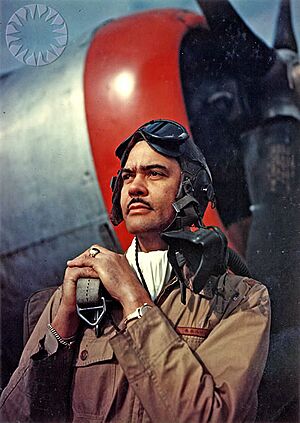
Colonel Davis and his 332nd Fighter Group arrived in Italy soon after. This group was known as the "Red Tails" because of the special red markings on their planes. They flew many missions deep into German territory. The Red Tails had an amazing record against the German air force. They flew over 15,000 missions, shot down 112 enemy planes, and destroyed many more on the ground. They lost only about 25 bombers they were protecting. Davis himself led 67 missions. He earned the Silver Star and the Distinguished Flying Cross for his bravery.
Standing Up for His Men
In 1945, there was an event called the Freeman Field mutiny. This happened when black officers were unfairly kept out of an officers' club. Colonel Davis was one of the officers who oversaw the trials that followed. He worked to ensure fairness for his men.
A Leader in the United States Air Force
In 1948, President Harry S. Truman ordered the racial integration of the armed forces. This meant that black and white service members would serve together. Colonel Davis helped create the plan for the Air Force to become the first service to fully integrate.
Over the next 20 years, Davis served at the Pentagon and in other countries. He even helped create the Air Force Thunderbird flight demonstration team. In 1953, he fought again in the Korean War, commanding the 51st Fighter-Interceptor Wing and flying an F-86 Sabre. He also served in Japan and Taiwan.
In 1957, General Davis went to West Germany. He was promoted to major general in 1959. In 1961, he returned to the U.S. Air Force Headquarters. In 1965, he became a lieutenant general and served in Korea and the Philippines. He retired from military service on February 1, 1970.
On December 9, 1998, President Bill Clinton honored Davis by promoting him to a full general in the U.S. Air Force (retired). Davis also wrote his autobiography, Benjamin O. Davis Jr.: American: An Autobiography.
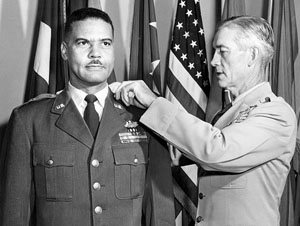
Awards and Achievements
After retiring from the military, General Davis continued to serve his country. He led the federal sky marshal program, which helps keep flights safe. In 1971, he became Assistant Secretary of Transportation. He worked on airport security and highway safety. He was a strong supporter of the 55 mile per hour speed limit, which helped save gas and lives. He retired from the Department of Transportation in 1975.
His military awards included:
 Air Force Distinguished Service Medal
Air Force Distinguished Service Medal Army Distinguished Service Medal
Army Distinguished Service Medal Silver Star
Silver Star Legion of Merit
Legion of Merit Distinguished Flying Cross
Distinguished Flying Cross Air Medal
Air Medal Army Commendation Medal
Army Commendation Medal Philippine Legion of Honor
Philippine Legion of Honor- Congressional Gold Medal (awarded to the Tuskegee Airmen in 2006)
- In 1992, he received the Langley Gold Medal from the Smithsonian Institution.
The Davis Line
General Davis also played a role in international relations. In 1955, he helped define a "median line" in the Taiwan Strait. This line helped keep peace between People's Republic of China and Republic of China by creating a boundary that neither side would cross.
Honors and Legacy
- In 2002, scholar Molefi Kete Asante named Davis as one of the 100 Greatest African Americans.
- Several schools are named in his honor, including Benjamin O. Davis Jr Aerospace Technical High School in Detroit, Michigan, and Benjamin O. Davis High School in Houston, Texas.
- The Benjamin O. Davis Jr. Award is given to senior members of the Civil Air Patrol.
- In 2015, West Point named a new building after him.
- He was inducted into the International Air & Space Hall of Fame in 1996.
- On November 1, 2019, the airfield at the United States Air Force Academy was renamed Benjamin O. Davis, Jr. Airfield.
His Final Years
General Davis's wife, Agatha, passed away in March 2002. Davis, who had been battling Alzheimer's disease, died at age 89 on July 4, 2002, in Washington, D.C. He was buried with Agatha at Arlington National Cemetery. During his funeral, a Red Tail P-51 Mustang, like the one he flew in World War II, flew overhead. President Bill Clinton said that General Davis proved that "a person can overcome adversity and discrimination, achieve great things... and through example and perseverance, one person can bring truly amazing change."
See also
 In Spanish: Benjamin Oliver Davis para niños
In Spanish: Benjamin Oliver Davis para niños
- Davis line
- Executive Order 9981
- List of Tuskegee Airmen
- List of Tuskegee Airmen Cadet Pilot Graduation Classes
- Military history of African Americans


